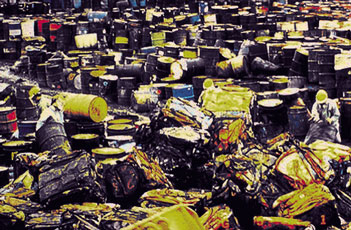|
Rotten Library > Crime > Superfund
Superfund The Superfund happened because of the events in a development called Love Canal in NY in the 1970's. A site that had previously contained toxic chemicals still had toxic chemicals, but they'd been "contained" and the land was sold for redevelopment as, of all things, a school. The group that owned the school had more of this toxic land left over after building on it, so they sold these extra land parcels to be used for homes. Chemical waste dumps now used as schools and homes: Welcome to America!
The Superfund happened because of the events in a development called Love Canal in NY in the 1970's. A site that had previously contained toxic chemicals still had toxic chemicals, but they'd been "contained" and the land was sold for redevelopment as, of all things, a school. The group that owned the school had more of this toxic land left over after building on it, so they sold these extra land parcels to be used for homes. Chemical waste dumps now used as schools and homes: Welcome to America!
People started getting sick in droves and this caused a major problem; how to pay for the cleanup. In the kind of forward-thinking and costly insanity that the government has become famous for, the Comprehensive Environmental Response, Compensation and Liability Act of 1980 (CERCLA) was passed, allocating an amount of money set aside for chemical cleanup in situations where the company who had originally polluted was gone. Of course, saying that it was "an amount of money set aside" is kind of like calling Montana "a patch of land": to date, over $30 billion dollars have gone into this project. Hence, it wasn't enough in the press to say it was a "fund", but to call it a "Superfund". Superfund means lots of different things to lots of people. To the Environmental Protection Agency, Superfund is a fantastic tool for Getting the Job Done: pour money into getting some toxic area clean, and then use more of the money to track down and sue/extract the cleanup costs from the offenders. To the Chemical and Manufacturing sector, Superfund is a gigantic out of control government mess, putting unrealistic retroactive standards upon sites that were legal decades and decades ago when they last left them. It's like waking up and finding out that all those times you ate paste in kindergarden, you were commiting a felony and had to go to jail; this will be a big surprise to you and your family thirty years later. Superfund was starting to get a little unhealthy in 1986, when it got a nice shot in the arm with the passage of the Superfund Amendments and Reauthorization Act (SARA), which really gave it some cash to work with. Superfund continues to this day, with the usual arguments and battles over who's doing what wrong, how inefficient or efficient the process is, and who gets to claim the credit when the occasional site actually gets somewhat cleaned up. (Out of tens of thousands of sites earmarked, of which a couple thousand are "priorities", about a hundred have ultimately been cleaned.) Of course, it took no time for the term "Superfund" to mean "this entire location is completely toxic beyond all reasonable measure", and to find out a plot of land was a "Superfund Site" meant doom for real estate values and the potential for dozens of lawsuits if any of your kids had so much as a sniffle. Just saying "Superfund" near a plot of land that once held some sort of factory will cause a housing glut within months; people know what's good for them. Luckily for Whitey, the vast majority of Superfund sites tend to be located in poor urban areas, where everyone already knew they were doomed. Superfund Fun Fact: The most priority Superfund sites are located in New Jersey, The Garden State. This should surprise, well, no one.... except for someone who's living on one of the sites. |